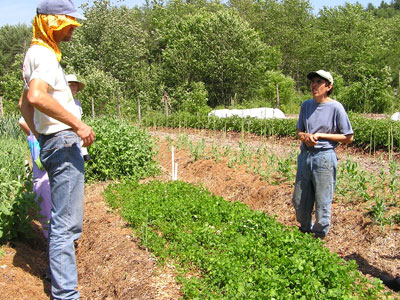 |
| Hank Colletto talks about raised bed gardening and green manuring during a farm tour at Ravenwood. English photo. |
Sustainability Education on a Small Farm in Searsmont
By Jean English
Inch by inch, row by row, sustainability project by sustainability project, teachers and students at Ravenwood, an education-focused small farm in Searsmont, Maine, have created an ecological Mecca where nutrients and energy cycle close to home.
Ravenwood dates back to 1970, when Chris and Karl Olson, newly graduated from Earlham College in Indiana, bought the land and dubbed it “Seek-No-Further” Farmstead after a heritage apple found there. In 1972 they founded Grassroots Educational Expeditions to teach skills in problem solving, group participation and practical arts, and to interest others in nature.
The Olsons led summer programs at Seek-No-Further Farmstead and Odyssey trips to Greece, and in winter did development work in Haiti, until 1984, when Chris died from a brain tumor. Karl became a medical doctor and now practices in Idaho.
Audubon Folks Take Charge
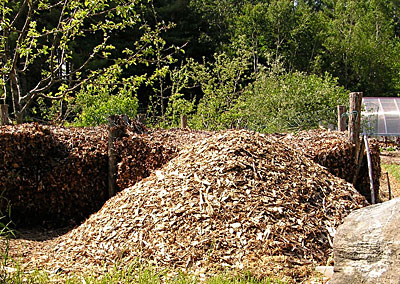 |
| Chips from small-diameter deciduous trees are an important compost ingredient at Ravenwood. English photo. |
The farm sat, mostly empty, until 1995, when three Audubon Expedition Institute faculty bought it. Now it is owned by Hank Colletto; Coleen O’Connell; Karin Whittmann; and Lily Fessenden and Glenn Ritch; who own their own 2-acre plots with homes, while the group co-owns the rest of the 175 acres.
The group’s two key goals are land stewardship and education, and their main focus is teaching sustainable practices and simple living.
Colletto says he’s been gardening organically at Ravenwood for 15 years but has been trying to figure out how to do that sustainably – i.e., cycling nutrients and energy on the farm as much as possible, and limiting dependence on outside inputs – for only the past seven years.
Those efforts seem to be thriving. Ravenwood features 1/2 acre in vegetables, berries, fruit, herbs and flowers; a solar powered and gravity-fed irrigation system; a 16- x 32-foot greenhouse; outdoor baking oven; waste vegetable oil-powered electric generator; photovoltaic array; bicycle-powered grain grinder; hand-operated clothes washer; composting toilets; straw-bale insulated student library; and 170 acres of forest.
Many of the gardens and structures were built with help from students who attend Ravenwood’s undergraduate short courses of up to three weeks long and semester courses that teach simple living skills and sustainable practices.
For example, a six-credit, three-week-long sustainability course offered through Unity College this summer involved living in tents in a field alongside the gardens and handy to the library/study, solar-heated showers, summer kitchen and composting toilets. Students would learn, in hands-on classes, about:
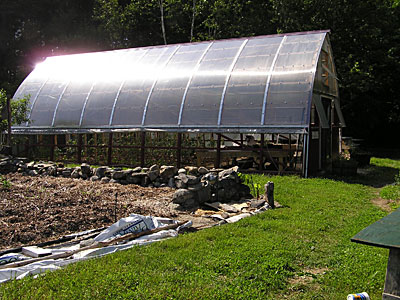 |
| The greenhouse is a recent addition to the farm. English photo. |
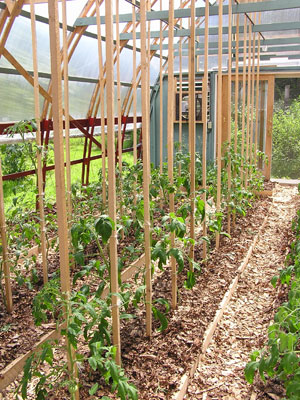 |
| Wooden stakes support tomato plants in the greenhouse. English photo. |
• small-scale organic agriculture
• wild edibles
• beekeeping
• raising chickens
• wholesome and healthy cooking
• composting
• passive solar design
• photovoltaic systems
• energy conservation techniques
• bread making in an outdoor oven
• simple living skills
• greenhouse growing techniques
• measuring their ecological footprint
A typical day may include waking to the sound of ravens, tending chickens (including getting their water from a well with a hand-pump), eating a breakfast of Ravenwood’s eggs, vegetables and bread, joining morning meeting to choose a job for the day – e.g., planting a green manure crop; working on a solar-powered irrigation system – then breaking for lunch. The afternoon may include a class on solar building or other skills, after which students finish their morning jobs and may begin another job. Dinner and a time for reflection may be followed by an educational video in the library, then sleep.
Other programs have included a 16-credit fall sustainable practices course for Lesley University; a three-week, six-credit summer program for Lesley; a three-hour program in sustainable agriculture and green technologies for Elder Hostel; the Ravenwood Sustainability Discovery Tour for Tanglewood 4H Camp; Sustainable Agriculture Service Learning Education for Montessori School children; a sustainable gardening workshop for Belfast Eco-village members; a sustainability education program for the “Education in a Changing Climate” Conference for Unity College; and the Sheepscot Wellspring Land Alliance garden tour and sustainable backyards tour.
Great Gardens
In making a garden, Colletto emphasizes the importance of the perimeter. To keep noxious perennial weeds such as quackgrass from creeping in, he initially mulches a strip about 3 feet wide around gardens with black plastic, which he salvages from lumber yards that would otherwise throw it out. Once this kills the grass, he plants the perimeter with perennials that support humans and/or animals, such as medicinal herbs, elderberries, asparagus and raspberries. He leaves a strip 6 inches or so in width unplanted, covering it with gravel and sinking straight stones vertically to further discourage weed incursion. A side benefit of mulch is that snakes, salamanders and frogs love it. On one side of the garden, recycled plywood is used facing flat down to provide snake habitat.
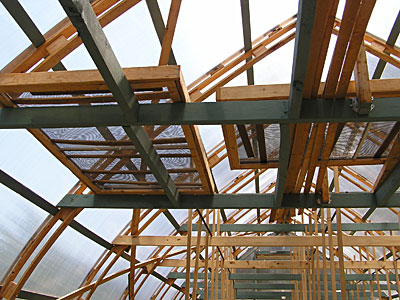 |
| Herbs and other garden produce can dry on these screens in the greenhouse. English photo. |
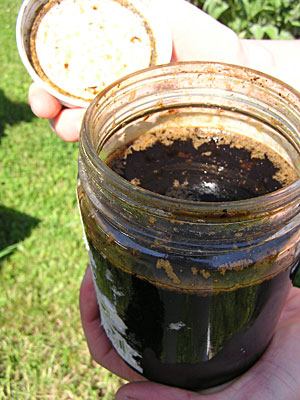 |
| A liquid fertilizer made from comfrey leaves nourishes plants as needed. English photo. |
Ravenwood’s main garden consists of beds raised about 1 foot high, amended and mulched with a wealth of organic matter. “To have soil showing is like a wound on my arm,” says Colletto. “I cover it with all kinds of things.”
Wood chips are one important mulching resource. At Ravenwood, a strip of mostly maple and cherry trees at the edge of the garden is coppiced so that new sprouts grow continually. The sprouts are cut every other year and are run through a chipper powered by a generator fueled with recycled waste vegetable oil – an $1,800 system.
Because the chips come from young sprouts, they are higher in nutrients (including nitrogen) than chips from older wood, so they do not tie up nitrogen when added to the soil. When used as mulch, the chips are not incorporated into the soil, further preventing the possibility of nitrogen tie up. When the chips are not needed for mulch, they’re composted for future use.
Since mulch attracts slugs, Colletto patrols the garden early in the morning and again at dusk to collect slugs and feed them to chickens, or to squish them.
Green manure crops also enrich the beds. Several were planted with a mix of oats and peas in early summer, and some grew Mammoth red clover. Colletto sometimes lets the clover grow for two years, then cuts it with a scythe and adds it to compost, or smothers it with black plastic mulch for three weeks before planting an edible crop.
In addition to wood chips and green manures, Ravenwood gets shredded leaves from a nearby cemetery; and compost made from wood chips, food waste and comfrey also enriches the soil.
Russian comfrey grows outside the gardens, in a permanent strip, where it accumulates nutrients. The plant flowers but “it’s very unlikely to go to seed,” says Colletto, and will spread out of bounds only if its roots are cut up and distributed (so the roots should never be put in compost). It “produces a lot of biomass for the compost pile,” he notes. In addition, gardeners at Ravenwood fill 55-gallon barrels with comfrey and let it sit for three or four weeks, without adding any water. The succulent plants release their moisture and nutrients, which settle in the bottom of the barrels. This liquid is drawn off and diluted up to 20-fold to fertilize greenhouse crops and garden plants when necessary.
Ravenwood’s garden beds contain 8 percent organic matter – almost unheard of in such a sandy soil. This helps keep them moist, even though they’re raised so high. “We don’t have to water,” says Colletto, “but we get more production if we do.”
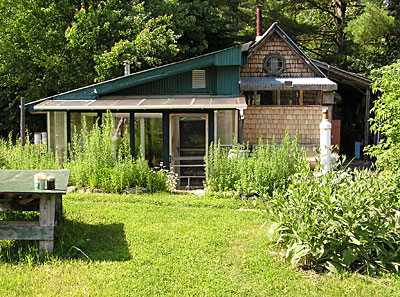 |
| The straw bale library, solar heated showers and summer kitchen English photo. |
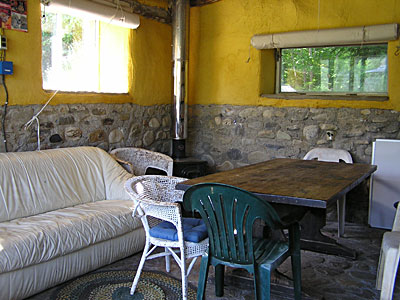 |
| A stone foundation and straw bale walls insulate the library, which also serves as a meeting and gathering spot for students. English photo. |
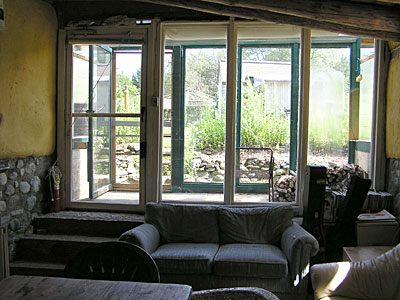 |
| Looking out of the meeting room through a small, attached greenhouse. English photo. |
A newer garden has beds flush with the ground. Drainage is not a problem, because Ravenwood’s sand goes down about 80 feet, but Colletto says the level beds are more difficult to work with a broadfork than the raised beds. All beds are worked by hand, using a broadfork to maintain aeration and mix in compost.
All food grown on the farm stays on the farm.
Multipurpose Room
A very energy efficient building serves as a dining room, library, study and place for students to hang out in the evening. The lower walls of the below-grade building are made from concrete and rocks from the land. Incorporating rocks limited the amount of concrete needed, and 75 percent of the concrete consists of sand from Ravenwood’s land. The rock wall is backed by 6 inches of foam insulation that prevents heat accumulated in the walls from moving out to the earth.
The upper straw bale walls are coated with plaster made mostly from materials found on the land (and a little hydrated lime, purchased). Wood for the rafters and roof came from the land.
The glass front wall of the building is insulated by a narrow greenhouse space, so sunlight is the primary source of heat for the building. A small wood stove supplements the sun on cold, cloudy days. Even this is efficient: A pipe sucks air from outside the building into the firebox, so warm air in the room is not moving into the stove and out the chimney. “This is one thing you can do in an old house,” says Colletto. “Build a room around a furnace, and pipe in air from outside.”
Bread Baking Day
Residential course participants bake bread once a week to learn this simple living skill and to learn about the health value of whole grains. The night before baking day, students grind enough wheat berries to make flour for seven days worth of bread and other baked goods. They may learn more about bread by planting, harvesting, drying, threshing and winnowing wheat, although Ravenwood does not grow enough wheat for all its baking.
One group of students attached an old exercise bike to a grain mill, and since then the cast-iron, hand-cranked grinder is used less – although it does work better with the dent corn grown at Ravenwood and is used to make flour for tortillas and cornbread.
Water for the bread dough comes from a deep-well hand pump that is not limited by the usual 27-or-so-foot depth of many hand-operated suction pumps. The water is either gathered at the pump or shunted through a pipe into a tank 10 feet above the kitchen sink; from there, gravity moves it into the sink. “We think it is essential to make alternative systems easy to use in order to promote simple living skills and ensure their use,” says Ravenwood on its website.
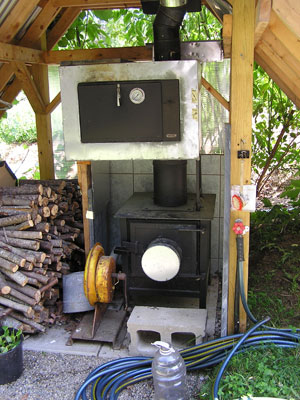 |
| Students bake bread in this outdoor wood-fired oven. English photo. |
When the dough is ready, students bake bread in a super-efficient wood-fired outdoor oven. The fire chamber is constructed from an old steel wood stove, and the oven is a steel box within another box with 4 inches of insulation between the two. In order to use less firewood, heat from the wood stove moves through a rocket elbow to the oven, directly heating the bread rather than heating an earthen or steel mass to indirectly heat the bread. The wood gatherers fell trees and cut them to length with a hand saw, then split them with an axe. A designated fire tender is crucial in the baking process. To track their ecological footprint, students tally the weight of the wood, along with any other resources they consume.
Shower Time
Students’ ecological footprint for showers is almost nil, as 300 feet of black tubing on the roof of the summer kitchen preheats the water, and a batch type solar heater further heats the water for showers. Wastewater from the showers flows into a constructed wetland and then waters the comfrey bed.
Irrigation
While a well supplies potable water, Ravenwood collects roof water in barrels for other purposes, including spot irrigating the garden. Also, two 5,000-gallon polyethylene barrels on a hill on the property hold water – from a seasonal stream just above the barrels until that stream dries up in mid-July; then from Thompson Brook for the rest of the summer. A solar powered pump moves water from the brook up an 18-foot rise and into the barrels. From there, gravity feeds it 75 feet down to an irrigation system in the greenhouse, gardens and raspberry plantings; and to the showers. This system uses no batteries; the solar pump works when the sun shines, and water sits in the barrels until it’s needed. A shut-off system keeps the barrels from overflowing. This student-built system cost about $4,000, which includes $1,000 each for the barrels.
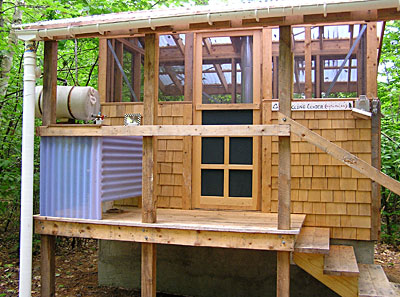 |
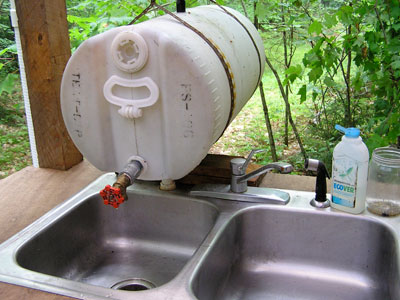 |
| This attractive, roomy composting toilet system has two toilets – one for current use, and one under which material composts for a year. English photo. | Water collected from the roof is available for washing hands. English photo. |
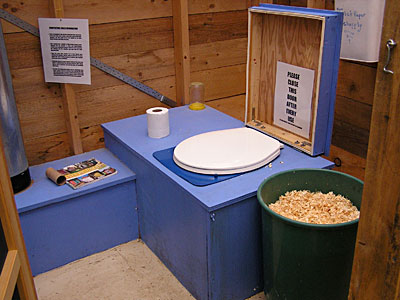 |
The facility is bright, pretty and clean. English photo. |
The wood-framed greenhouse, also student-built, is a recent addition to Ravenwood. Last winter, its first, it overwintered kale, Swiss chard and lettuce in permanent beds. This summer, tomatoes grew up a trellis made of 1-inch-square spruce posts. Screens sit on the purlins in the greenhouse, providing a place to dry herbs and other garden produce.
Composting Toilets
Three years ago students built a composting toilet, based on a Gap Mountain Permaculture design. If Martha Stewart had a composting toilet, this would be the one. It is light and airy, painted a pretty blue, comfortable and functional. Even the reading material is appropriate to the cause and is color coordinated with the building.
Each of the two toilets sits on top of a 4- x 4- x 4-foot pit chamber with a concrete slab floor and concrete block walls that are insulated so that composting continues long into the fall. Screening supported 16 inches above the concrete floor holds a layer of hay, leaves, forest duff and red wiggler worms and catches feces from above. Students cover each deposit with wood shavings. One toilet is used, while material in the chamber under the other toilet composts for a year. When the compost is cleaned from the chamber, it is composted for another year in an outdoor covered bin, then it fertilizes forest trees or black walnut trees. A urine diversion toilet moves urine to a lined pit outside that is filled with wood chips, leaves and other carbonaceous material.
Projects at Ravenwood are labor intensive, but students supply much of that labor as they learn. One of the few things leaving the farm is knowledge, as over the years Ravenwood has educated many students.
For more information:
Ravenwood, 150 Barrett Rd., Searsmont, ME 04973;
[email protected];
www.ravenwoodeducation.com
www.facebook.com/pages/Searsmont-ME/Ravenwood-Education/106304366066298?ref=ts
